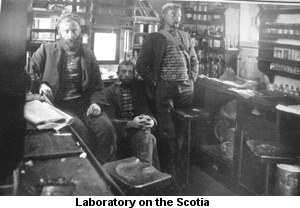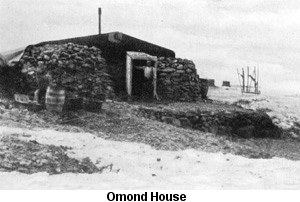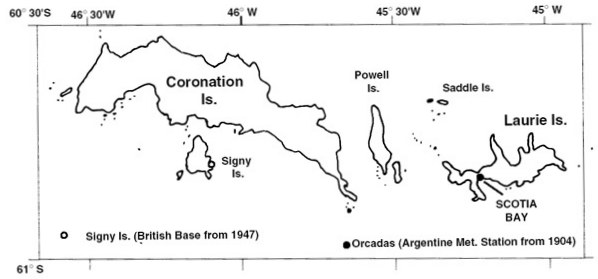
| Glasgow Digital Library | Voyage of the Scotia | BRUCE | PEOPLE | SHIP | ANTARCTIC | INDEX |
|---|

On 29 March 1903 the ice closed around Scotia and she was beset for the winter. As water freezes, the brine (salt) comes out of the ice which is then frozen fresh water. This brine which lies on the surface makes it very slushy (like salt on roads in winter) until the intense cold of winter freezes the surface.
Preparations were made for winter in the bay. The ship's upper yards were lowered to reduce the strain on the spars in high wind, the engine was shut down for a winter service and the boats were put onto the ice to provide more deck space. A snow wall was built around the ship to cut down the effect of the wind, and snow was allowed to lie on the deck for insulation. Fires in the crew quarters kept them warm.
There was plenty of work for the 33 crew members over the winter months, but at first much time was spent in preparation. One of the major tasks was the construction of a house made of moraine and scree. This was the shore base for the meteorological observations and was also to be the base for a small group to be left on Laurie Island while Scotia went to Buenos Aires for her refit in the spring.
Bruce reverted to Scottish dry stone dyke construction and over 100 tons of stones were used to produce a hut only 4.25 metres (14 feet) square. The walls were one to two metres (3-6 feet) thick, with sand and fine rubble between the boulders.
Scotia did not have enough room to carry timber for a large hut, although the Copeland laboratory for magnetic observations was built of wood (only two metres or seven feet square). This hut held the magnetometer.

The roof of the main house had one of the spare yards supporting a canvas cover. The new house was called Omond House after the chief meteorologist of the Ben Nevis observatory (which was of similar construction).
On the beach above Scotia Bay a three-metre high (nine-foot) cairn more than 2.5m (eight feet) in diameter was constructed. In the centre of the cairn was a flagpole which was to be the base point for surveying Laurie Island in the spring.
The daily routine included hourly meteorological observations, daily tide observations, magnetic observations, study of the wildlife and the preparation of specimens (skinning and preserving animals and birds).
Once the ice had covered the bay, holes were maintained in the ice. One of these was for safety so that water could be pumped up in case of fire. Traps were also set under the ice and dredging operations were carried out throughout the winter.
Dredging was done by maintaining two holes in the ice with a continuous loop of rope. The dredge was pulled down one hole and back up the next. On the next dredge the operation was reversed.
Beards and moustaches
During the stay in Scotia Bay many of the crew grew beards. Over the winter months when working outside quite often the beards and moustaches froze together and required thawing out before a meal could be eaten. A beard when frozen could be broken at no discomfort to the owner.
There were many hours in the evening when on-board entertainment took place. This was very important to maintain morale. Music-hall entertainment was provided by the crew and card-playing was popular - particularly poker played for matches or candles. The ship had a phonograph or record player and almost 60 records. The library was well stocked with novels and scientific journals.

South Orkney Islands 1904
| Glasgow Digital Library | Voyage of the Scotia | BRUCE | PEOPLE | SHIP | ANTARCTIC | INDEX |
|---|